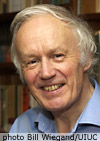
A. J. Leggett
Nobel Laureate in Physics, 2003
Dept. of Physics, University of Illinois at Urbana-Champaign
According to quantum mechanics, the theory used by physicists to describe
nature at the atomic level, an electron or atom faced with two alternative
routes or possibilities can in some sense realize both simultaneously. But
everyday objects consist of electrons or atoms; can they also "have their cake
and eat it"? Can a cat be simultaneously dead and alive? I will review
the conceptual basis of this paradox and describe the physics of the
systems ("superconducting quantum interference devices" or SQUIDs) which
have permitted some spectacular recent experimental input to it. I will
speculate on possible future developments in this area.
 For more information
about A. J. Leggett, visit his web
site.
Additional resources for this talk: video.
To view the movie you may need to download Quicktime.
|

